Retail trade, except of motor vehicles and motorcycles, repair of personal and household goods dominated the sector in terms of number of establishments
- A total of 366,185 establishments were covered in the 2005 Annual Survey of Philippine Business and Industry (ASPBI) for Wholesale and Retail Trade; Repair of Motor Vehicles, Motorcycles and Personal and Household Goods Sector. Establishments with an average total employment (ATE) of less than 20 had a total of 360,112 (98.3%) and only 6,073 (1.7%) were establishments with ATE of 20 or more. ( See Tables 1 to 3)
- Retail trade, except of motor vehicles and motorcycles, repair of personal and household goods (PSIC G52) dominated the industry covering 291,004 or 79.5 percent of the total establishments in the sector. This was followed by sale, maintenance and repair of motor vehicles and motorcycles; retail of automotive fuel (PSIC G50), which accounted to 42,981 or 11.7 percent. On the other hand, wholesale and commission trade, except of motor vehicles and motorcycles (PSIC G51) recorded the least with 32,200 establishments or 8.8 percent. Figure 1 shows the distribution of establishments by industry division.
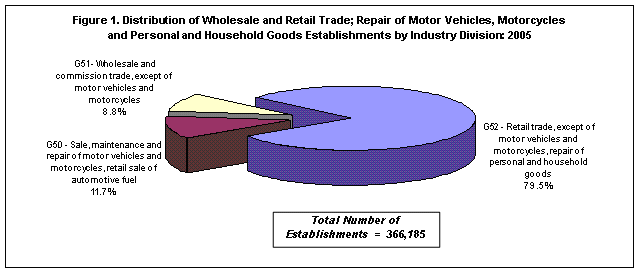
Nearly half of the wholesale and retail trade establishments with employment of 20 or more were concentrated in the National Capital Region
- Regionwise, nearly one-half (45.6 percent) or 2,771 of the total number of establishments in the country were concentrated in National Capital Region (NCR). Neighboring regions of Southern Tagalog and Central Luzon rank second and third, respectively. Autonomous region in Muslim Mindanao reported the least number of establishments with only 9 (0.15 percent). Figure 2 shows the distribution of establishments with ATE 20 or more by region.
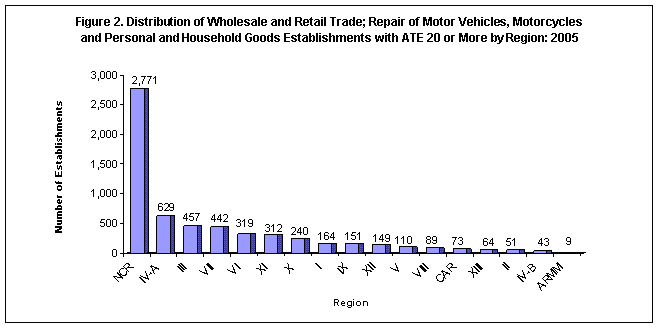
Retail trade establishments employed about three-fourths workers of the sector in 2005
- The sectors employment for 2005 reached a total of 1.77 million workers. The total workforce comprised of 1.35 million paid employees and 420,690 working owners and unpaid workers (76.2% and 23.8%), respectively.
- Establishments engaged in retail trade, except of motor vehicles and motorcycles, repair of personal and household goods (PSIC G52) remained the top employer accounting to 1.32 million workers (74.8%) or about three-fourths of the total employment in 2005. Figure 3 shows the distribution of employment for wholesale and retail trade; and repair services by industry division.
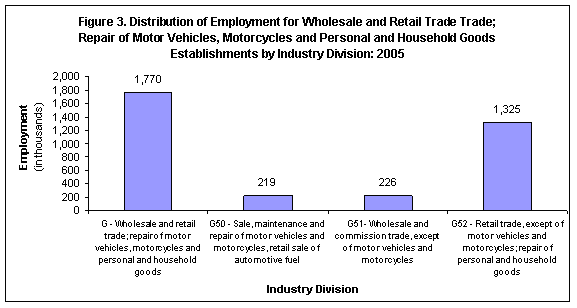
- Wholesale and commission trade, except of motor vehicles and motorcycles (PSIC G51) continued to be the leading industry in terms of average employment per establishment with 7 employees. This exceeded the sectors average of 5 workers per establishment. (See Table R1)
Wholesale and commission trade workers, highest earners with average monthly compensation of Php 8,841.
- In 2005, the compensation paid to employees by the sector amounted to Php 95.4 billion or equivalent to an average annual income of Php 70,718.
- The wholesale and commission trade (PSIC G51) employees received the highest average monthly compensation of Php 8,841. This also surpassed the sectors average monthly compensation of Php 5,893. Lowest earners were retail trade workers (PSIC G52) with only Php 5,286. Figure 4 shows the average monthly compensation per employee for wholesale and retail trade; and repair services.
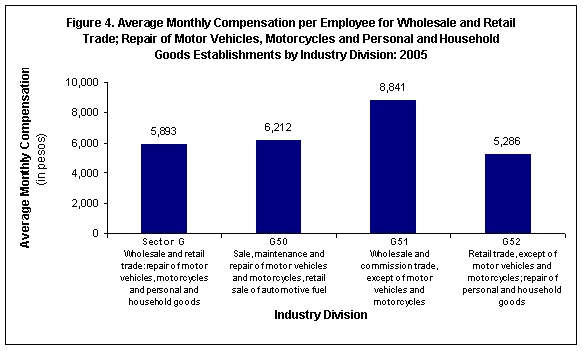
Retail trade and repair services, top grosser in terms of revenue and expenditures
- Total revenue earned by the wholesale and retail trade; repair of motor vehicles, motorcycles and personal and household goods sector in 2005 amounted to Php 1,799.36 billion. More than half (54.3%) or Php 976.7 billion of the income was generated by retail trade, except of motor vehicles and motorcycles; repair of personal and household goods (PSIC G52). The average sales or revenue per establishment for the sector amounted to Php 4.91 million.
- Labor productivity, in terms of revenue per worker, registered at Php 1.017 million for the sector. Wholesale and commission trade, except of motor vehicles and motorcycles (PSIC G51) exhibited the highest labor productivity at Php 2.108 million. This was followed by sale, maintenance and repair of motor vehicles and motorcycles; retail sale of automotive fuel (PSIC G50) with Php 1.483 million. On the other hand, retail trade, except of motor vehicles and motorcycles; repair of personal and household goods (PSIC G52) registered the lowest at Php 737 thousand. (See Table R1).
- Operational costs for all establishments in 2005 totaled to Php 1,624.87 billion. Retail trade, except of motor vehicles and motorcycles; repair of personal and household goods (PSIC G52) which registered the biggest income also had the highest portion in expenditure amounting to Php 872.7 billion (53.7%). The average cost per establishment amounted to Php 4.44 million.
- Revenue per peso cost of the wholesale and retail trade; repair services sector in 2005 was Php 1.11. The share in terms of revenue-costs by industry division is shown in Figure 5.
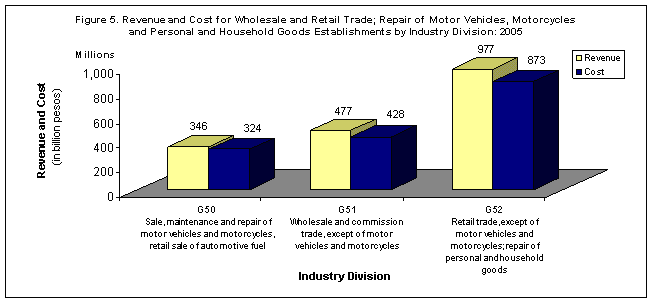
- Another measure of labor productivity is value added per paid employee. It amounted to an average of Php 175 thousand. Likewise by industry division, wholesale and commission trade, except of motor vehicles and motorcycles (PSIC G51) registered the highest labor productivity at Php 359.5 thousand. Sale, maintenance and repair of motor vehicles and motorcycles, retail sale of automotive fuel (PSIC G50) and retail trade, except of motor vehicles and motorcycles; repair of personal and household goods (PSIC G52) followed with Php 173.2 thousand and Php 140.9 thousand, respectively. (See Table R1)
Total Gross Margin amounted to almost Php 310 billion
- In 2005, total gross margin for the sector reached Php 309.97 billion. Retail trade, except motor vehicles and motorcycles, repair of personal and household goods (PSIC G52) was the top grosser with Php 179.43 billion, followed by wholesale and commission trade, except of motor vehicles and motorcycles (PSIC G51) with Php 94.05 billion. Sale, maintenance and repair of motor vehicles and motorcycles, retail sale of automotive fuel (PSIC G50) had the least share of 11.8 percent (Php 36.49 billion) to total gross margin.
Retail trade contributed more than half of total additions to fixed assets and total change in inventories
- Retail trade, except of motor vehicles & motorcycles, repair of personal and household goods (PSIC G52) acquired the biggest share of Php 7.78 billion or 52.5 percent of the total additions to fixed assets for the year 2005.
- Total change in inventories of the sector in 2005 reached to Php 27.6 billion. More than half (64.0%) or Php 17.6 billion was contributed by the retail trade.
- Subsidies received by wholesale and retail trade; repair services to aid and develop an industry amounted to Php 276 million. Seven out of nineteen industry groups availed the subsidies granted by the government.
TECHNICAL NOTES
Scope and Coverage
The 2005 Annual Survey of Philippine Business and Industry (ASPBI) formerly known as Annual Survey of Establishments (ASE) was conducted to collect information on the structure and trends of economic activities in the entire country for the year 2005. Covered were establishments engaged in economic activities as defined under the 1994 Philippine Standard Industrial Classification (PSIC).
These establishments were classified into 14 sectors one of which is on Wholesale and retail trade sector; repair of motor vehicles, motorcycles and personal and household goods (Sector G), which covered all establishments, except sari-sari stores with no regularly paid employee and open stalls in public market. The sector is composed of establishments engaged in three industry division namely, sale, maintenance and repair of motor vehicles and motorcycles, retail sale of automotive fuel (G50); wholesale trade and commission trade, except of motor vehicles and motorcycles (G51); and retail trade, except of motor vehicles and motorcycles, repair of personal and household goods (G52).
All wholesale and retail trade; repair of motor vehicles, motorcycles and personal and household goods establishments nationwide with average total employment (ATE) of 200 and over were covered on a 100 percent basis and those with ATE of less than 200 were selected using simple random sampling.
Response Rate
A total of 2,154 or 95.69 percent responded out of the 2,251 samples drawn for the sector but effective response rate is 62.86 percent only. Adjustments for non-response were made through imputations.
Concepts and Definition of Terms
Establishment - an economic unit, which engages under a single ownership or control, i.e. under a single legal entity, in one, or predominantly one kind of economic activity at a single fixed location.
Economic activity or business - is the activity of the establishment as classified under the1994 Philippine Standard Industrial Classification (PSIC). The main activity refers to the activity that contributes the biggest or major portion of the gross income or revenue of the establishment.
Wholesale Trade and Commission Trade Establishment - a store, shop, office, bazaar, arcade or emporium engaged in the resale of new and used goods to retailers, industrial/commercial/institutional/professional users, or to other wholesalers and trading in behalf and on the account of others.
Retail Trade Establishment - a store, shop, mart, bazaar, sari-sari store, pharmacy, supermarket, grocery, arcade or emporium engaged in the resale of new and used goods to the general public.
Repair Service Establishment - a shop specializing in the repair of consumer goods like footwear, luggage, handbags and gloves and other leather goods, electrical appliances, and equipment as television and radio receivers, refrigerators, washing machines, ironers, vacuum cleaners, toasters, motor vehicles including motorcycles; watch, clock and jewelry; bicycles; typewriters, cameras, binoculars, musical instruments, umbrellas, etc.
Total Employment - is the number of persons who worked in or for the establishment as of November 15, 2003.
Paid employees - are all persons working in the establishments receiving pay as well as those working away from the establishment when paid by and under the control of the establishment. Included are persons working as full-time or part-time and those employees on sick leave, paid vacation or holiday. Excluded are consultants, home workers and workers receiving commission only.
Unpaid workers - include working owners who do not receive regular pay, apprentices and learners without regular pay, and persons working without regular pay for at least one third of the working time normal to the establishment.
Salaries and wages - are payments in cash or in kind, prior to deduction for employees contribution to SSS/GSIS, withholding tax, etc. Included are total basic pay, vacation, sick, maternity leave pay, overtime pay, and other benefits.
Revenue - refers to cash received and receivables for goods sold and services rendered.
Cost - refers to all expenses excluding compensation incurred during the year whether paid or payable. Valuation should be at market price including taxes and other charges, net of discounts, rebates, returns and allowances. Goods received from and services rendered by other establishment of the same enterprise are valued as though purchased.
Gross Margin - is the difference between the values of goods sold on own account (including commission received on sale on account of others) during the inquiry period and the gross cost of these goods. The gross cost of goods is the value of purchased of goods intended for sale adjusted for stock change of these goods during the inquiry period.
Gross additions to fixed assets - refer to the cost of acquisition of fixed assets acquired in 2003 less the value of sales of fixed assets during the year.
Fixed assets - are physical assets expected to have productive life of more than one year and intended for use and/or being used by the establishment. Included are land, buildings, fixtures, machinery, tool, furniture, office equipment, vehicles, and the like.
Capital expenditures - refer to the cost of acquisition of fixed assets acquired in 2001 whether or not full payments have been made.
Change in Inventories - as a derived indicator, is computed as the value of ending inventory less the value of beginning inventory.
Subsidies - are special grants in the form of financial assistance or tax exemption or tax privilege given by the government to develop an industry or production and to protect it against competition.
Inventories - refer to stocks of goods owned by or under the control of the establishment as of a fixed date, regardless of where the stocks are located. Valuation should be at current replacement cost in purchasers price at the indicated dates. Replacement cost is the cost of an item in terms of its present price rather than its original price.
Value Added - is equal to the total revenue plus capital expenditures produced on own account plus change in inventories less total cost (net of indirect taxes, interest expense, depreciation and bad debts).
Source: National Statistics Office
Manila, Philippines
